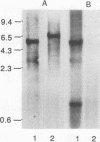Abstract
We recently concluded that M protein mediates adherence of group A streptococci to HEp-2 tissue culture cells, because the N-terminal half of M protein blocked adherence and M+ strains attached in greater numbers than M- streptococci. To further assess the role of M protein in adhesion, an M-, isogenic mutant of M type M-, isogenic mutant of M type 24 group A streptococci was constructed by insertional inactivation of the emm24 gene with the omega-interposon flanked by emm24 gene sequences. Southern blot analysis confirmed that the omega-element inserted only into emm24. The M- isogenic mutant M24-omega 3 did not react with antiserum to M24 protein, not did it survive in whole human blood. Electron micrographs of M24-omega 3 showed a diminution of surface fibrillae and reduced binding of plasma components compared with the parent strain. The adhesion of the M+ parent to HEp-2 cells and to mouse oral epithelial cells was dramatically greater than the adhesion of the M24-omega 3 mutant, although there was no difference between the two in adhesion to human buccal cells. In addition, the parent strain was dramatically more effective than the M24-omega 3 mutant in colonizing the oral cavity of mice. These results indicate that the M24 protein can serve as an adhesin in streptococcal attachment to human cells in tissue culture and is important in the colonization of mouse mucosal surfaces.
Full text
PDF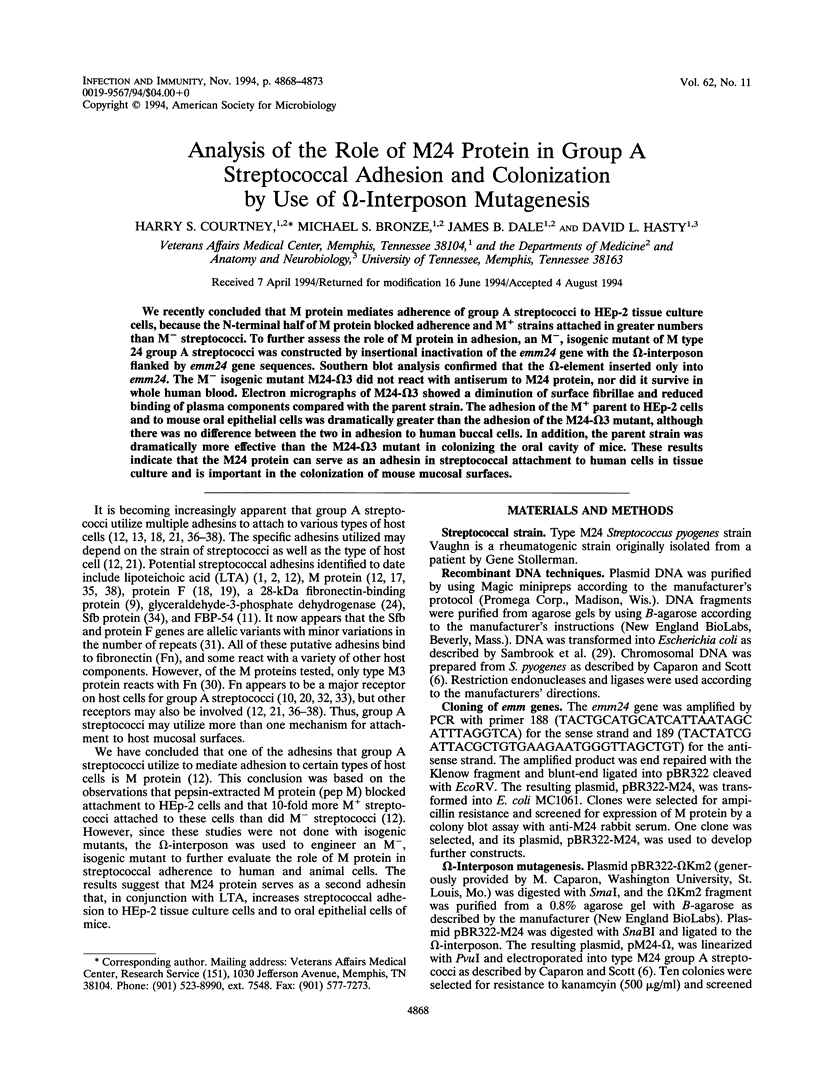
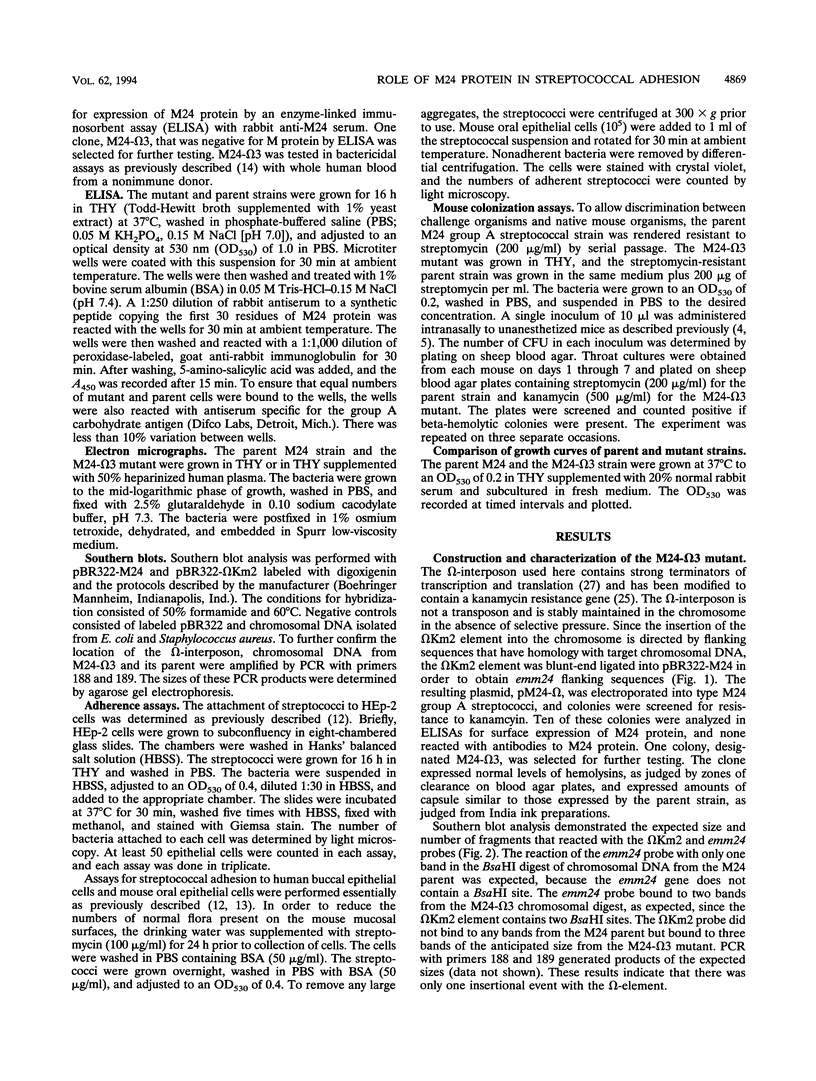

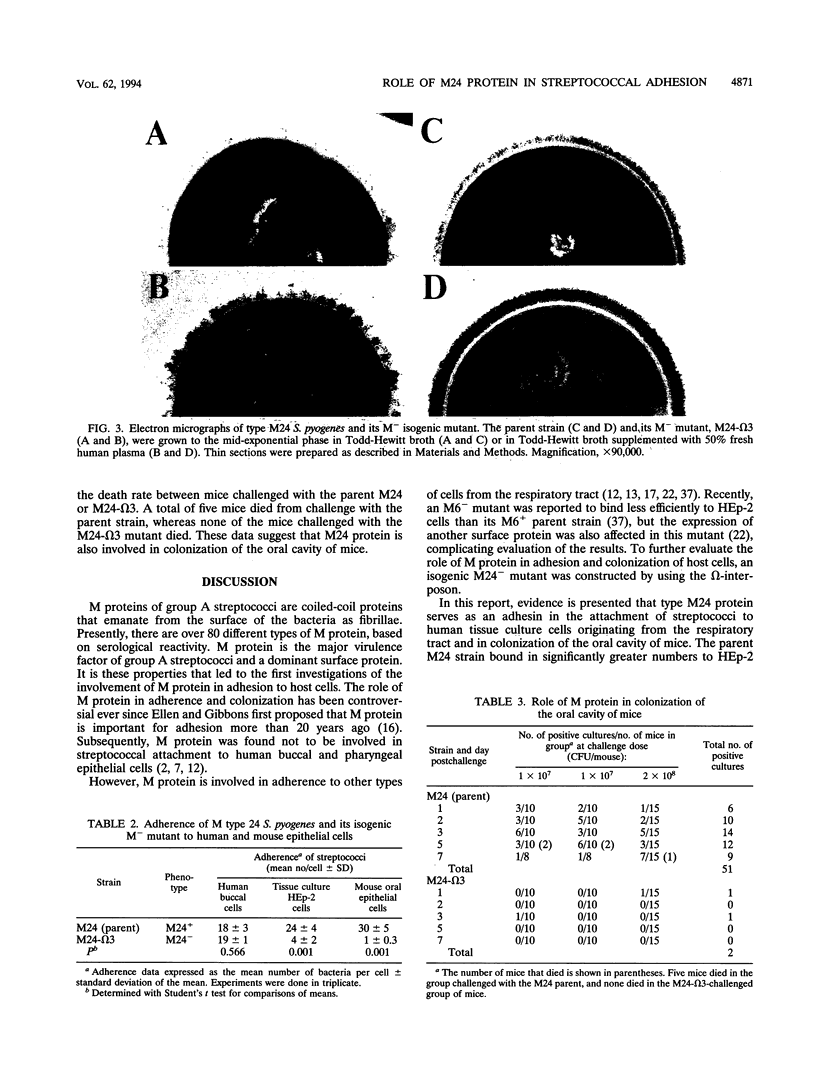

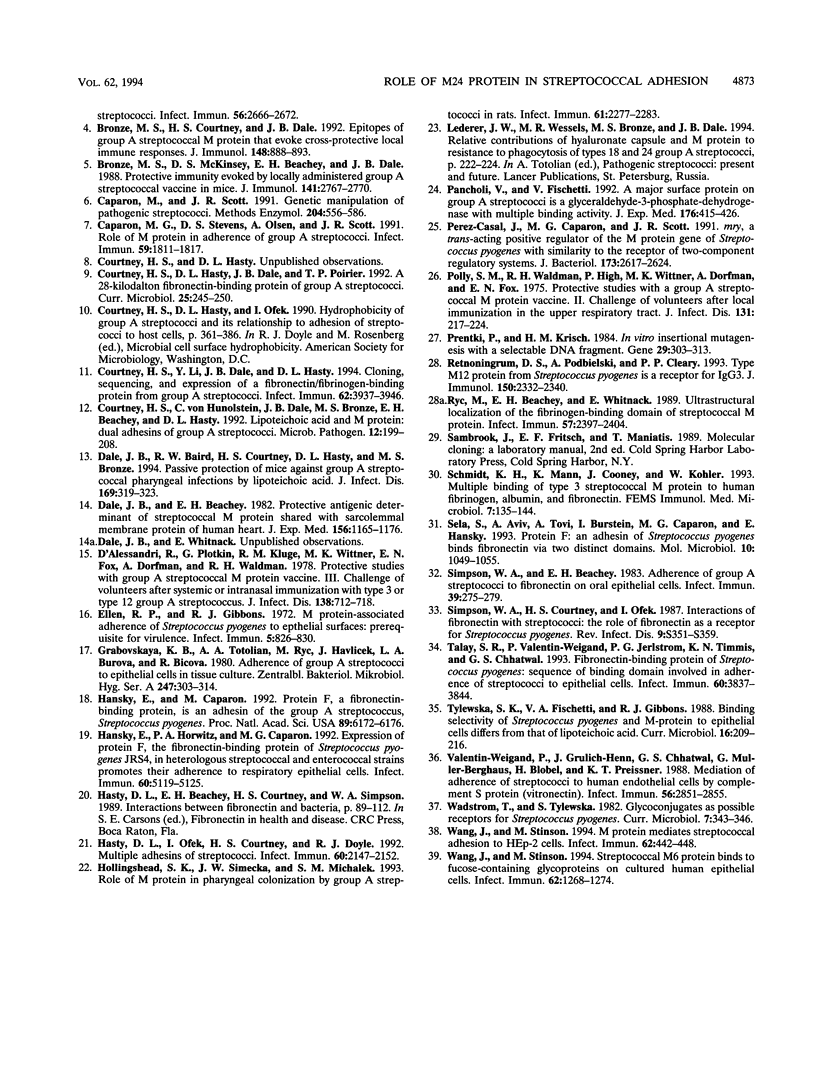
Images in this article
Selected References
These references are in PubMed. This may not be the complete list of references from this article.
- Beachey E. H., Courtney H. S. Bacterial adherence: the attachment of group A streptococci to mucosal surfaces. Rev Infect Dis. 1987 Sep-Oct;9 (Suppl 5):S475–S481. doi: 10.1093/clinids/9.supplement_5.s475. [DOI] [PubMed] [Google Scholar]
- Beachey E. H., Ofek I. Epithelial cell binding of group A streptococci by lipoteichoic acid on fimbriae denuded of M protein. J Exp Med. 1976 Apr 1;143(4):759–771. doi: 10.1084/jem.143.4.759. [DOI] [PMC free article] [PubMed] [Google Scholar]
- Bessen D., Fischetti V. A. Influence of intranasal immunization with synthetic peptides corresponding to conserved epitopes of M protein on mucosal colonization by group A streptococci. Infect Immun. 1988 Oct;56(10):2666–2672. doi: 10.1128/iai.56.10.2666-2672.1988. [DOI] [PMC free article] [PubMed] [Google Scholar]
- Bronze M. S., Courtney H. S., Dale J. B. Epitopes of group A streptococcal M protein that evoke cross-protective local immune responses. J Immunol. 1992 Feb 1;148(3):888–893. [PubMed] [Google Scholar]
- Bronze M. S., McKinsey D. S., Beachey E. H., Dale J. B. Protective immunity evoked by locally administered group A streptococcal vaccines in mice. J Immunol. 1988 Oct 15;141(8):2767–2770. [PubMed] [Google Scholar]
- Caparon M. G., Scott J. R. Genetic manipulation of pathogenic streptococci. Methods Enzymol. 1991;204:556–586. doi: 10.1016/0076-6879(91)04028-m. [DOI] [PubMed] [Google Scholar]
- Caparon M. G., Stephens D. S., Olsén A., Scott J. R. Role of M protein in adherence of group A streptococci. Infect Immun. 1991 May;59(5):1811–1817. doi: 10.1128/iai.59.5.1811-1817.1991. [DOI] [PMC free article] [PubMed] [Google Scholar]
- Courtney H. S., Hasty D. L., Dale J. B., Poirier T. P. A 28-kilodalton fibronectin-binding protein of group A streptococci. Curr Microbiol. 1992 Nov;25(5):245–250. doi: 10.1007/BF01575856. [DOI] [PubMed] [Google Scholar]
- Courtney H. S., Li Y., Dale J. B., Hasty D. L. Cloning, sequencing, and expression of a fibronectin/fibrinogen-binding protein from group A streptococci. Infect Immun. 1994 Sep;62(9):3937–3946. doi: 10.1128/iai.62.9.3937-3946.1994. [DOI] [PMC free article] [PubMed] [Google Scholar]
- Courtney H. S., von Hunolstein C., Dale J. B., Bronze M. S., Beachey E. H., Hasty D. L. Lipoteichoic acid and M protein: dual adhesins of group A streptococci. Microb Pathog. 1992 Mar;12(3):199–208. doi: 10.1016/0882-4010(92)90054-r. [DOI] [PubMed] [Google Scholar]
- D'Alessandri R., Plotkin G., Kluge R. M., Wittner M. K., Fox E. N., Dorfman A., Waldman R. H. Protective studies with group A streptococcal M protein vaccine. III. Challenge of volunteers after systemic or intranasal immunization with Type 3 or Type 12 group A Streptococcus. J Infect Dis. 1978 Dec;138(6):712–718. doi: 10.1093/infdis/138.6.712. [DOI] [PubMed] [Google Scholar]
- Dale J. B., Baird R. W., Courtney H. S., Hasty D. L., Bronze M. S. Passive protection of mice against group A streptococcal pharyngeal infection by lipoteichoic acid. J Infect Dis. 1994 Feb;169(2):319–323. doi: 10.1093/infdis/169.2.319. [DOI] [PubMed] [Google Scholar]
- Dale J. B., Beachey E. H. Protective antigenic determinant of streptococcal M protein shared with sarcolemmal membrane protein of human heart. J Exp Med. 1982 Oct 1;156(4):1165–1176. doi: 10.1084/jem.156.4.1165. [DOI] [PMC free article] [PubMed] [Google Scholar]
- Ellen R. P., Gibbons R. J. M protein-associated adherence of Streptococcus pyogenes to epithelial surfaces: prerequisite for virulence. Infect Immun. 1972 May;5(5):826–830. doi: 10.1128/iai.5.5.826-830.1972. [DOI] [PMC free article] [PubMed] [Google Scholar]
- Grabovskaya K. B., Totoljan A. A., Rýc M., Havlícek J., Burova L. A., Bícová R. Adherence of group A streptococci to epithelial cells in tissue culture. Zentralbl Bakteriol A. 1980 Aug;247(3):303–314. [PubMed] [Google Scholar]
- Hanski E., Caparon M. Protein F, a fibronectin-binding protein, is an adhesin of the group A streptococcus Streptococcus pyogenes. Proc Natl Acad Sci U S A. 1992 Jul 1;89(13):6172–6176. doi: 10.1073/pnas.89.13.6172. [DOI] [PMC free article] [PubMed] [Google Scholar]
- Hanski E., Horwitz P. A., Caparon M. G. Expression of protein F, the fibronectin-binding protein of Streptococcus pyogenes JRS4, in heterologous streptococcal and enterococcal strains promotes their adherence to respiratory epithelial cells. Infect Immun. 1992 Dec;60(12):5119–5125. doi: 10.1128/iai.60.12.5119-5125.1992. [DOI] [PMC free article] [PubMed] [Google Scholar]
- Hasty D. L., Ofek I., Courtney H. S., Doyle R. J. Multiple adhesins of streptococci. Infect Immun. 1992 Jun;60(6):2147–2152. doi: 10.1128/iai.60.6.2147-2152.1992. [DOI] [PMC free article] [PubMed] [Google Scholar]
- Hollingshead S. K., Simecka J. W., Michalek S. M. Role of M protein in pharyngeal colonization by group A streptococci in rats. Infect Immun. 1993 Jun;61(6):2277–2283. doi: 10.1128/iai.61.6.2277-2283.1993. [DOI] [PMC free article] [PubMed] [Google Scholar]
- Pancholi V., Fischetti V. A. A major surface protein on group A streptococci is a glyceraldehyde-3-phosphate-dehydrogenase with multiple binding activity. J Exp Med. 1992 Aug 1;176(2):415–426. doi: 10.1084/jem.176.2.415. [DOI] [PMC free article] [PubMed] [Google Scholar]
- Perez-Casal J., Caparon M. G., Scott J. R. Mry, a trans-acting positive regulator of the M protein gene of Streptococcus pyogenes with similarity to the receptor proteins of two-component regulatory systems. J Bacteriol. 1991 Apr;173(8):2617–2624. doi: 10.1128/jb.173.8.2617-2624.1991. [DOI] [PMC free article] [PubMed] [Google Scholar]
- Polly S. M., Waldman R. H., High P., Wittner M. K., Dorfman A. Protective studies with a group A streptococcal M protein vaccine. II. Challange of volenteers after local immunization in the upper respiratory tract. J Infect Dis. 1975 Mar;131(3):217–224. doi: 10.1093/infdis/131.3.217. [DOI] [PubMed] [Google Scholar]
- Prentki P., Krisch H. M. In vitro insertional mutagenesis with a selectable DNA fragment. Gene. 1984 Sep;29(3):303–313. doi: 10.1016/0378-1119(84)90059-3. [DOI] [PubMed] [Google Scholar]
- Retnoningrum D. S., Podbielski A., Cleary P. P. Type M12 protein from Streptococcus pyogenes is a receptor for IgG3. J Immunol. 1993 Mar 15;150(6):2332–2340. [PubMed] [Google Scholar]
- Rýc M., Beachey E. H., Whitnack E. Ultrastructural localization of the fibrinogen-binding domain of streptococcal M protein. Infect Immun. 1989 Aug;57(8):2397–2404. doi: 10.1128/iai.57.8.2397-2404.1989. [DOI] [PMC free article] [PubMed] [Google Scholar]
- Schmidt K. H., Mann K., Cooney J., Köhler W. Multiple binding of type 3 streptococcal M protein to human fibrinogen, albumin and fibronectin. FEMS Immunol Med Microbiol. 1993 Aug;7(2):135–143. doi: 10.1111/j.1574-695X.1993.tb00392.x. [DOI] [PubMed] [Google Scholar]
- Sela S., Aviv A., Tovi A., Burstein I., Caparon M. G., Hanski E. Protein F: an adhesin of Streptococcus pyogenes binds fibronectin via two distinct domains. Mol Microbiol. 1993 Dec;10(5):1049–1055. doi: 10.1111/j.1365-2958.1993.tb00975.x. [DOI] [PubMed] [Google Scholar]
- Simpson W. A., Beachey E. H. Adherence of group A streptococci to fibronectin on oral epithelial cells. Infect Immun. 1983 Jan;39(1):275–279. doi: 10.1128/iai.39.1.275-279.1983. [DOI] [PMC free article] [PubMed] [Google Scholar]
- Simpson W. A., Courtney H. S., Ofek I. Interactions of fibronectin with streptococci: the role of fibronectin as a receptor for Streptococcus pyogenes. Rev Infect Dis. 1987 Jul-Aug;9 (Suppl 4):S351–S359. doi: 10.1093/clinids/9.supplement_4.s351. [DOI] [PubMed] [Google Scholar]
- Talay S. R., Valentin-Weigand P., Jerlström P. G., Timmis K. N., Chhatwal G. S. Fibronectin-binding protein of Streptococcus pyogenes: sequence of the binding domain involved in adherence of streptococci to epithelial cells. Infect Immun. 1992 Sep;60(9):3837–3844. doi: 10.1128/iai.60.9.3837-3844.1992. [DOI] [PMC free article] [PubMed] [Google Scholar]
- Valentin-Weigand P., Grulich-Henn J., Chhatwal G. S., Müller-Berghaus G., Blobel H., Preissner K. T. Mediation of adherence of streptococci to human endothelial cells by complement S protein (vitronectin). Infect Immun. 1988 Nov;56(11):2851–2855. doi: 10.1128/iai.56.11.2851-2855.1988. [DOI] [PMC free article] [PubMed] [Google Scholar]
- Wang J. R., Stinson M. W. M protein mediates streptococcal adhesion to HEp-2 cells. Infect Immun. 1994 Feb;62(2):442–448. doi: 10.1128/iai.62.2.442-448.1994. [DOI] [PMC free article] [PubMed] [Google Scholar]
- Wang J. R., Stinson M. W. Streptococcal M6 protein binds to fucose-containing glycoproteins on cultured human epithelial cells. Infect Immun. 1994 Apr;62(4):1268–1274. doi: 10.1128/iai.62.4.1268-1274.1994. [DOI] [PMC free article] [PubMed] [Google Scholar]



